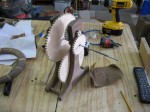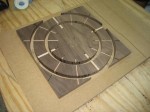Wooden Gear Clock
Posted 2007-06-14 Tweet
The Idea
To build a wooden clock using metal only where absolutely required.
There are many more pictures available in the Photo Gallery.
The Design
The overall design was inspired by a clock design I saw on the internet. Unfortunately the links are now missing. I did not have any plans available, so I created my own design based on the images. The gear templates were taken from various free plans available from the Internet. Oddly, no one single plan had the gears I needed, I had to take them from several sources.
The clock seems to keep great time, and it should, as long as the AC power coming into the house is at 60hz.
Materials
The main wood is black walnut. The marker inlays are maple. The gears are cut from Baltic birch plywood. This material is used because it is composed of many layers, without any significant voids. This is desirable for cutting gears, because they are unlikely to warp. The hands of the clock are Bolivian Rosewood, for contrast.
Building
The most important feature to make this clock work properly is the gearing ratio between the various gears. The AC powered motor runs at 1 rpm, which means it has a internal gear reduction of 1:3600 (it runs from the 60hz ac power). The gears that run the minute hand must be reduced 60:1, which is accomplished through 2 sets of gears, each using an 8 tooth on one side, and a 60 tooth on one set, and a 64 tooth on the other. The last set of gears reduces the hour hand by 1:12. The two sets of gears for this ratio are 8 tooth with a 32 tooth, and a 10 tooth with a 30 tooth.
Each of the gears were cut free-hand, using a scroll saw, and spiral cut blades. Amazingly, I only made a mistake on my very first gear, and had to start over on only that one. Cutting the gears took many hours and a lot of patience.
The face piece was made by routing grooves into a piece of black walnut, installing the maple strips, and sanding them flush. The circle was then cut using a circle jig and a router, 2 cuts were made to form the inside and outside surfaces.
The assembly and fitting of all of the gears, bearings, shafts, motor, was tricky to say the least. Fortunately it all came together without any major mistakes.
Chuck Hays works at Google as an SWE on the Duo team.
Chuck was formerly a Senior SDE at Microsoft working on the Azure AppPlat team.
Chuck lives in Minnesota and is an alumnus of the University of Minnesota with a master's degree in Computer Science & robotics.




